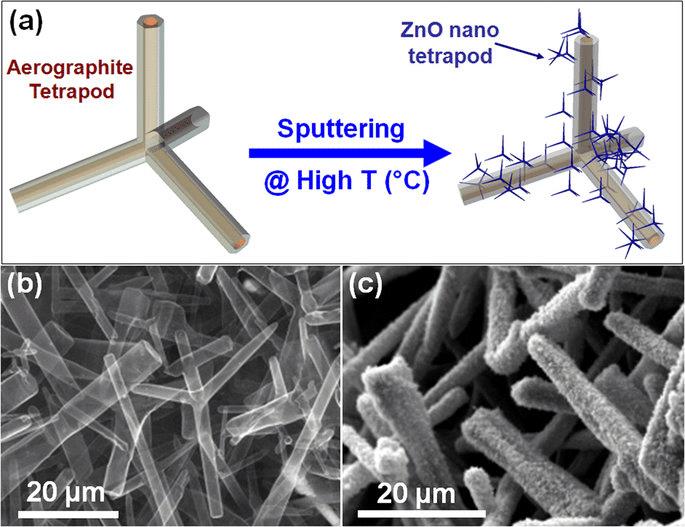

SEM images demonstrate the morphologies of tetrapodes before (b) and after (c) the sputtering process.
Image: Yogendra Mishra
Light is absorbed differently, depending on the material it shines on. An international research team including material scientists from Kiel University has created a complex hybrid material with the ability to absorb light with a unique broad range of wavelengths. In addition to that it scatters light which makes it really interesting for industrial applications.That could mean an important step in optoelectronic technologies towards laser light as a successor to LEDs.
The results published in Nature Scientific Reports represent the output of a broad international collaboration, including scientists from Germany, Moldova, Denmark and Australia.
“As material scientists we are always in demand to develop nanomaterials that can absorb a wide range of light,” explains Dr. Yogendra Mishra.
He is leading an independent subgroup of the Functional Materials working group of Professor Rainer Adelung, Institute for Materials Science at Kiel University. This group has expertise in making tetrapods, four-armed zinc oxide structures. “We have now made tetrapods in a new way and created a hybrid material of carbon and inorganic material. It demonstrates the ability to absorb a broad range of wavelengths from ultraviolet to infrared – and it also diffuses light,” Mishra explains. “The complex 3D-tetrapod-architecture of our material spreads light in all directions.”
This scattering effect of the hybrid material is urgently needed for using laser based lighting in optoelectronic technologies as in automobile industry. “Products of modern light technology should be as bright as possible without producing a lot of useless heat. That is the case with a normal bulb, which have almost become museum artefacts. The LEDs of today are better but powerful laser-based lights would be most efficient,” says material scientist Mishra. The reason why Laser based lighting has not yet been realized for a broad application in industry is exactly its power, which could damage the eyes.
Therefore, the international research team tried to develop hybrid material elements which can degrade the brightness of laser light while maintaining its high power. That is the effect of the complex 3D-tetrapod-architecture of the new hybrid material, developed in a close collaboration. At the Hamburg University of Technology (TUHH) the zinc oxide tetrapods from Kiel were transformed into aerographite tetrapods of carbon.
A team from the Technical University of Moldova used its special sputtering machine to put a huge amount of smaller zinc oxide nanocrystals – also with the shape of tetrapods – on its surface. The result is a hybrid material with a fascinating spatial architecture consisting of Aerographite microtetrapods decorated with zinc oxide nanotetrapods. Colleagues from the University of Copenhagen and the University of Sydney investigated different properties of the newly developed nanomaterial.
“The zinc oxide-Aerographite hybrid architectured materials are technologically very important and our goal was to develop cost-effective approaches for their fabrication as well as to achieve a proper understanding of their unique properties,” says Professor Ion Tiginyanu, Director of the National Centre for Materials Study and Testing at the Technical University of Moldova. Used as a scattering element, the research team is convinced that the material is a very promising candidate for optoelectronic technologies, especially since the technological process behind it is simple and economical.
Original publication
Ion Tiginyanu, Lidia Ghimpu, Jorit Gröttrup, Vitalie Postolache,
Matthias Mecklenburg, Marion A. Stevens-Kalce, Veaceslav Ursaki, Nader Payami, Robert Feidenhansl, Karl Schulte, Rainer Adelung, Yogendra Kumar Mishra. Strong light scattering and broadband (UV to IR) photoabsorption
in stretchable 3D hybrid architectures based on Aerographite decorated by ZnO nanocrystallites. Sci. Rep. 6, 32913, doi: 10.1038/srep32913 (2016).
Photos are available to download:
http://www.uni-kiel.de/download/pm/2017/2017-084-1.jpg
An international research team developed a hybrid nano material with a fascinating structure of tetrapods. Image: Yogendra Mishra
http://www.uni-kiel.de/download/pm/2017/2017-084-2.jpg
During the sputtering process Aerographite microtetrapods get decorated with zinc oxide nanotetrapods. Image: Yogendra Mishra
http://www.uni-kiel.de/download/pm/2017/2017-084-3.jpg
SEM images demonstrate the morphologies of tetrapodes before (b) and after (c) the sputtering process.
Image: Yogendra Mishra
http://www.uni-kiel.de/download/pm/2017/2017-084-4.jpg
The scattering behaviour of the new nano hybrid material (generated by a laser pointer with green light) degrades the brightness of laser light. That way it becomes more applicable for industry.
Photo: Yogendra Mishra
http://www.uni-kiel.de/download/pm/2017/2017-084-5.jpg
Dr. Yogendra Mishra from Kiel University shows the scattering property of the new nano hybrid material of carbon and zinc oxide.
Photo: Julia Siekmann, CAU
http://www.uni-kiel.de/download/pm/2017/2017-084-6.jpg
The laser light spreads over the material instead of concentrating on just one point.
Photo: Julia Siekmann, CAU
Contact:
PD Dr. habil. Yogendra Kumar Mishra
Group Leader: Functional Nanomaterials
Institute for Materials Science, Kiel University
Email: ykm@tf.uni-kiel.de
Phone:+49 431 880 6183
Ion Tiginyanu
Director of the National Centre for Materials Study and Testing
Technical University of Moldova
Email: tiginyanu@asm.md
Phone: +373 22 27 40 47
Details, which are only a millionth of a millimetre in size: This is what the research focus “Kiel Nano, Surface and Interface Science – KiNSIS” at Kiel University has been working on. In the nano-cosmos, different laws prevail than in the macroscopic world – those of quantum physics. Through intensive, interdisciplinary cooperation between materials science, chemistry, physics, biology, electrical engineering, computer science, food technology and various branches of medicine, the research focus aims to understand the systems in this dimension and to implement the findings in an application-oriented manner. Molecular machines, innovative sensors, bionic materials, quantum computers, advanced therapies and much more could be the result. More information at www.kinsis.uni-kiel.de
Christian-Albrechts-Universität zu Kiel
Presse, Kommunikation und Marketing, Dr. Boris Pawlowski, Redaktion: Julia Siekmann
Postanschrift: D-24098 Kiel, Telefon: (0431) 880-2104, Telefax: (0431) 880-1355
E-Mail: presse@uv.uni-kiel.de, Internet: www.uni-kiel.de, Twitter: www.twitter.com/kieluni Facebook: www.facebook.com/kieluni, Instagram: instagram.com/kieluni
http://www.uni-kiel.de/pressemeldungen/index.php?pmid=2017-084-laser&lang=en












